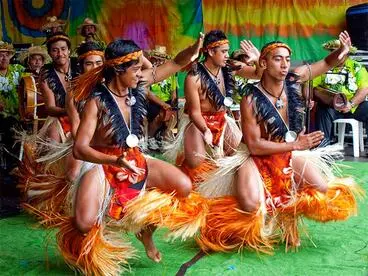Antarctica
A DigitalNZ Story by National Library of New Zealand Topics
Antarctica is our remotest continent and home to the South Pole. It is covered in ice and has two seasons, winter and summer. Some scientists living in Antarctica study its environment, sea-life — whales, penguins and seals and also global warming. SCIS no: 1887858
Commemorating the first Trans-Antarctic crossing 1957-8
This first-day envelope shows Edmund Hillary and Vivian Fuchs shaking hands in a snowy landscape.
Alexander Turnbull Library
Antarctica
National Library of New Zealand
Antarctica (junior)
National Library of New Zealand
Sid and Buck at Scott Base
Services to Schools
Iceberg and ship
Three paintings of Antarctic icebergs.
Alexander Turnbull Library
Images of the Chinstrap Penguin.
Museum of New Zealand Te Papa Tongarewa
Images of the Antarctic Petrel.
Museum of New Zealand Te Papa Tongarewa
Animal life in Antarctica
Newspaper article about penguins, killer whales and seals in Antarctica.
National Library of New Zealand
Antarctica and global climate change
Science Learning Hub
Huge Antarctic glacier melting
Radio New Zealand
Large jellyfish
Photograph of a large jellyfish at Cape Armitage, Antarctica.
Antarctica New Zealand
The hero of Antarctica
Newspaper article about Shackleton’s arrival in London, after his Antarctic expedition.
National Library of New Zealand
The Marine Minister
The Minister of Marine (Mr McAlpine) wearing padded clothing for a visit to Antarctica.
Alexander Turnbull Library
Norwegian whaler, Ross Sea, Antarctica
Manatū Taonga, the Ministry for Culture and Heritage
All Black and White (Ponting)
A painting by Nigel Brown.
Antarctica New Zealand
Food rations in Antarctica
One man's daily sledging food ration in Antarctica.
Alexander Turnbull Library
Bunk beds, Antarctica
Alexander Turnbull Library
One hundred and forty days under the world.
This striking Academy Award-nominated NFU documentary chronicles the 6-month polar summer of 1963/64.
NZ On Screen
Mending sleeping bags
Thomas Crean and Petty Officer Evans mending sleeping bags in Antarctica.
Alexander Turnbull Library
Mt Erebus
Manatū Taonga, the Ministry for Culture and Heritage
This film from 1958 documents New Zealanders in Antarctica including Edmund Hillary's famous dash to the South Pole.
NZ On Screen
Plaque in Four Languages near Shackleton's Hut
Antarctica New Zealand
Ice Lake, Antarctica
Martin Siegert, a glaciologist discusses the exploration of Antarctica's hidden lakes and rivers below the ice cap.
Radio New Zealand
Dinosaurs in Antarctica
Discovery of dinosaurs in Antarctica tells of warmer times in the frozen continent.
Radio New Zealand
The voice of an iceberg
Artist Joseph Michael and a team of eight film-makers head to Antarctica on the yacht Australis, to discover and record the sights and sounds of icebergs.
Radio New Zealand
Survival camp Antarctica
Services to Schools
A South Pole station
Services to Schools
Discovering Antarctica
Services to Schools
Antarctica New Zealand
Services to Schools
Massive iceberg breaks off from Antarctica
Services to Schools
Weather in the South Pole, Antarctica
Services to Schools
NZ's slice of Antarctica.
Services to Schools
10 facts about Emperor penguins
Services to Schools
Antarctica
Services to Schools
About Antarctica
Services to Schools
Educational resources
Services to Schools
Impacts of climate change
Services to Schools
Where is the coldest place on Earth?
Services to Schools
Aurora Australis
Services to Schools
The race to the South Pole
Services to Schools
Antarctica: the farthest place close to home
Services to Schools
Who is eating who? Connected L4 Year 7 : 2012
Services to Schools
Antarctica song
Services to Schools
From icebergs to pongas
Services to Schools
I’m a penguin
Services to Schools
Antarctic poetry
Services to Schools
Cool Antarctica
Services to Schools
Race? What race?
Services to Schools
Dance filmed in Antarctica
Services to Schools
Who owns Antarctica?
Services to Schools
Roald Amundsen
This head and shoulders portrait is of the Norwegian explorer Roald Amundsen. Amundsen commanded the first successful expedition to reach the South Pole. He set out in October 1911 and reached the South Pole on 14 December 1911. Amundsen was an experienced and skilled polar explorer and his journey to the South Pole there and back took 99 days.
Alexander Turnbull Library
Antarctica
Services to Schools
Captain Robert Scott
This photograph shows Captain Robert Falcon Scott writing at a table in his den at Cape Evans Antarctica during the British Antarctic ('Terra Nova') Expedition of 1910-1913. Scott is surrounded by books, clothes and photographs of family. Herbert George Ponting took the photograph in October 1911.
Alexander Turnbull Library
Camp near Erebus
Members of the British Antarctic ("Terra Nova") Expedition unpacking provisions and getting their camp in order, in January 1911. In the foreground, you can clearly see one of the sledges the exploration teams used to haul supplies. In the background are many stacked boxes of provisions to enable the expedition to safely winter-over.
Alexander Turnbull Library
The ship Fram
This ship Fram, (Forward) was part of Roald Amundsen's Norwegian expedition to Antarctica in 1910 -1912. It was also used to extensively explore the Arctic region.
Alexander Turnbull Library
Site of Robert Falcon Scott's tent
Frank Debenham's party erected this memorial cairn on the site of Robert Falcon Scott's tent. Scott and 2 others died in the tent on their way back from reaching the South Pole during the British Antarctic Expedition
Alexander Turnbull Library
Crown Studios Ltd of Wellington took this photograph of the First Byrd Expedition team. The 3 American expeditions lead by Rear Admiral Richard E Byrd made extensive use of technology in their exploration and scientific studies. On 28 November 1929, one of the expedition’s planes (the Floyd Bennett) made the first flight over the South Pole. Among the other technical innovations adopted were: aerial photography, a base generator plant, electric tools, a radio and photographic laboratory, and a magnetic observatory. One of the most interesting inventions was the Antarctic Snow Cruiser built for the third exhibition. This specially constructed monster truck held 5 crew and could travel up to 5000 miles across the frozen continent. Inside there was enough food for a year. A plane was mounted on top and the Snow Cruiser's front and rear wheels could be retracted to allow it to cross crevasses.
First Byrd Antarctic Expedition
Alexander Turnbull Library
Captain Scott
This portrait of Captain Scott during the British Antarctic ("Terra Nova") Expedition (1910-1913) shows him standing by a sledge in snow, and wearing cold weather clothing. The photograph was taken in April 1911 by the expedition photographer, Herbert Ponting.
Alexander Turnbull Library
Ponies pulling sledges
This photo shows ponies pulling sledges in the Antarctic, led by members of the British Antarctic ("Terra Nova") Expedition. The photograph was taken by their leader, Captain Robert Falcon Scott in 1911. Like the motorised sledges Scott also brought, the ponies were not a success and the final expedition team ended up pulling the sledges themselves.
Alexander Turnbull Library
‘Some day, son’ cartoon
In this cartoon by Michael Moreu, a group of penguins are standing on an ice shelf in Antarctica. One of them is toppling into the sea as a lump of ice breaks off. The father penguin says to his son that one day, 'none of this will be yours'. This refers to rapid climate change in a fast-warming region of Antarctica, (the western side of the Antarctic peninsula) as the cause of an initial collapse of the Wilkins Ice Shelf.
Alexander Turnbull Library
Admiral Dufek, Sir Edmund Hillary and Sir Vivian Fuchs
This publicity photo shows Admiral Dufek, Sir Edmund Hillary and Sir Vivian Fuchs greeting each other at the South Pole. The photograph was taken 20 January 1958. These men were all part of the 1955 - 58 Commonwealth Trans-Antarctic Expedition. Some of its successes included setting up Scott Base and Sir Edmund Hillary being the first to reach the South Pole using vehicles (converted tractors) on 3 January 1958.
Alexander Turnbull Library
Trans-Antarctic Expedition Share certificate
This public share certificate displays a map of Antarctica in the centre, penguins at the left, men with a ski sledge at the right, and a photographic portrait (and signature) of Sir Edmund Hillary below. It is one of the share certificates sold to raise funds for the 1956-58 Trans-Antarctic Expedition, which Sir Edmund Hillary successfully took part in.
Alexander Turnbull Library
South Polar journey begins
This page from the Weekly News shows photographs that include scenes from the Trans-Antarctic Expedition to Antarctica, with Dr Ron Balham, and Sir Edmund Hillary. Adapted for Antarctic conditions, the tractor trains hauled sledges carrying equipment, fuel, food and other supplies.
Alexander Turnbull Library
Antarctic film poster
This poster shows members of the British Antarctic Expedition (1910-1913) inside a tent, eating or drinking hot liquid from mugs, and seated around a central camp stove. Captain Robert Falcon Scott is identified at the right. “The main objective of this expedition," Captain Scott said, “is to reach the South Pole, and to secure for The British Empire the honour of this achievement."
Alexander Turnbull Library
The Astrolabe in pack-ice
Shows the ship Astrolabe, caught bow first in pack ice with the sea behind the ship. Sailors are hauling on ropes to help the ship to penetrate the ice and one man is attacking the ice with a pickaxe. The Astrolabe was commanded by Frenchman Jules Dumont d'Urville who explored the South Pacific (including Antarctica) between 1837 and 1840. On this trip, D’Urville named part of the continent of Antarctica (and a species of penguin) after his wife, Adélie Pepin. In 2005, Adélie Land served as the location for the popular French documentary, ‘March of the Penguins’.
Alexander Turnbull Library
Types of penguins
This painting shows 3 types of penguins, King penguins, Royal penguins, and Crested penguins. These are 3 of 6 penguin species living only in the Antarctic region. All 17 species of penguin are only found naturally in the Southern Hemisphere.
Alexander Turnbull Library
Flora studies
This drawing is of Celmisia vernicosa with descriptive notes and Forstera clavigerum showing details of leaf and stigmata. Both plants are sub-Antarctic. Celmisia vernicosa (now Damnamenia vernicosa) is a sub-Antarctic daisy confined to the Auckland and Campbell islands. Forsteria clavigerum (now Phyllachne clavigera) is an alpine and sub-Antarctic cushion plant from New Zealand's South Island and the New Zealand sub -Antarctic region.
Alexander Turnbull Library
This is a studio portrait of Ernest Henry Shackleton, one of last century's greatest Antarctic explorers. Initially, he accompanied Captain Scott on his first Antarctic expedition (1901-04) but today Shackleton is famous for the survival of his Imperial Trans-Antarctic Expedition. When the expedition’s ship (Endurance) was destroyed by pack ice, Shackleton's leadership skills ensured all the party survived an incredibly dangerous ordeal.
Photographer unknown: Ernest Henry Shackleton
Alexander Turnbull Library
Antarctic marine ecosystem
Services to Schools
Investigating data from the RV Tangaroa
Services to Schools
Go further south
Services to Schools
Endurance School Journal. Jan: 2020
Services to Schools
Science on ice School Journal. Nov: 2018
Services to Schools
Could you survive?
Services to Schools
Antarctic sea ice
Services to Schools
Destination Antarctica
Services to Schools
The Arctic vs. the Antarctic
Services to Schools
Antarctica: The heart of the world by Coral Tulloch
Services to Schools
Operation Antarctica
Services to Schools
Antarctica
Services to Schools
Dinosaur fossils in Antarctica
Services to Schools
A rainforest in Antarctica
Services to Schools
Tuati – first NZer to view Antarctica
Services to Schools
Classroom Antarctica
Services to Schools
Who is eating who? Year 7 : Connected L4 : 2012
Services to Schools
Signing of the Antarctic Treaty
Services to Schools
The Antarctica Collection
Services to Schools
Antarctic wind flow patterns
Services to Schools
Old ice gives insights into future sea level rise
Services to Schools
Countries of the World
DigitalNZ
Māori among first to see Antarctica
Services to Schools
The Endurance: Ernest Shackleton’s ship
Services to Schools








